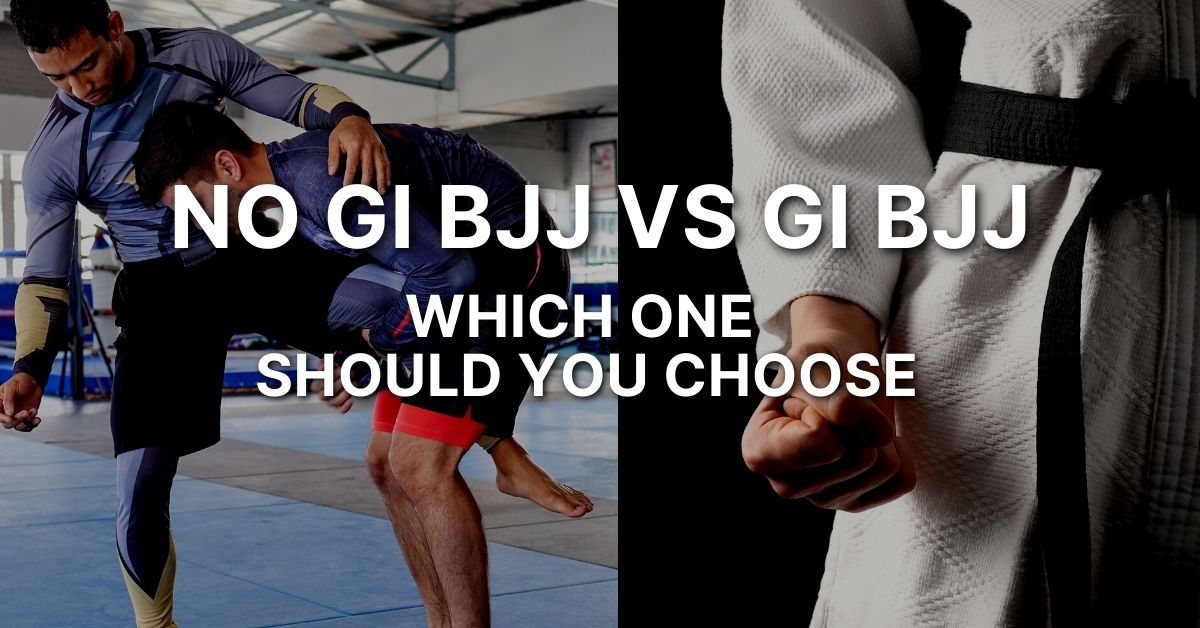Confused about Gi or No Gi Brazilian Jiu-Jitsu? You’re not alone! Here’s your guide to help you pick the best one. Let’s get started and understand the dissimilarities between the two.
No Gi BJJ Vs. Gi BJJ
Gi BJJ is practiced in a traditional martial arts uniform, while No Gi BJJ is practiced without it. We will discuss the differences between the two styles, their respective training methods, and which suits you best.
Gi BJJ teaches practitioners to focus on controlling opponents’ movements using gi grips, while No-Gi BJJ emphasizes body mechanics and movement.
In competitions, Gi BJJ follows the ruleset set by the International Brazilian Jiu-Jitsu Federation (IBJJF), which prohibits heel hooks and reaping.
In No-Gi BJJ, these moves are allowed in certain competitions like ADCC.
To better understand the differences between Gi and No-Gi BJJ, consider the story of renowned American BJJ legend Rafael Lovato Jr.
He started with traditional Gi BJJ but transitioned to No-Gi grappling as he found it more applicable in MMA fights and street fighting scenarios.

Growing Popularity of Brazilian Jiu-Jitsu
The popularity of Brazilian Jiu-Jitsu (started by the Gracie Family) has surged in recent years due to its effectiveness in self-defense and sports competitions.
This grappling style utilizes submissions and leglocks to overpower opponents, with distinct rulesets for gi and no gi styles.
No gi BJJ involves grappling without the traditional heavy cotton jacket or kimono, while gi BJJ teaches moves that require holding onto the opponent’s arms and clothing. Both styles offer a variety of techniques, from open guard to spider guard, selling alphabetically, and many more.
Many fighters focus on one style over another when preparing for competition or self-defense, depending on personal preference and goals.
However, it’s worth noting that some gyms offer courses that teach both gi and no gi classes to rank up in both styles for maximum flexibility.
It doesn’t matter what level you start Jiu Jitsu at – from white to black belts – wearing the proper clothing is crucial for optimal performance.
Rash guards are common apparel worn during sparring sessions or competitions as they reduce skin-to-skin friction while protecting against mat burns.
The versatility of the grappling style extends beyond the gym; it offers mental benefits such as increased self-confidence that can come from learning how to control body position effectively.
Importance of Jiu-Jitsu Preferences
Choosing between no-gi and gi BJJ styles can be daunting for any practitioner. It is an important decision that depends on your preferences, goals, and objectives. Your preferred style may also evolve as you gain more experience.
There are some significant differences between the two styles of BJJ. Gi jiu-jitsu includes traditional Japanese kimonos or “gis,” while no-gi grappling does not require any particular clothing.
Gi Jiu Jitsu teaches practitioners to grab onto their opponent’s clothes, while No-gi Jiu Jitsu does not allow this tactic. These fundamental differences impact techniques, moves, and strategies.
No gi Jiu-Jitsu focuses more on takedowns to get your opponent down and on the ground, while gi Jiu-jitsu tends to focus on open guard attacks and sweeping tactics using clothing grips.
Many people believe that no-gi Jiu-Jitsu is better suited for MMA fighters as it trains them to grapple without clothes, but many top-level competitors train both styles.
When choosing a Jiu Jitsu style, consider your needs beyond competition goals; perhaps self-defense or general fitness?
An added benefit of gi Jiu Jitsu is that it requires core strength, as performing many moves can be quite challenging when wearing heavier clothes, especially if they become sweaty.
Pro Tip: When competing, think big, starting from feet and going upwards (for example, attacking legs and then hips). This will help you keep track of your next move in any position – especially important considering different clothing between opponents can present various challenges for grip fighting!
Exploring Gi and No-Gi BJJ
Gi Jiu Jitsu is ideal for those looking to compete, as it requires a greater variety of techniques and is favored by traditionalists, such as Renzo Gracie. No-gi BJJ is more suited for self-defense and is favored by practitioners such as Rafael Lovato Jr. and Z.A. Price.
Unique details about these styles include Gi Jiu Jitsu is derived from judo, while no-gi is rooted in wrestling.
Rashguards are commonly worn during no-gi grappling to prevent mat burns and improve mobility. Most people start with this since the uniform can assist with learning new techniques and then transition to no-gi once they have a solid foundation.
Interestingly, the popularity of no-gi BJJ is steadily increasing, with numerous tournaments dedicated solely to this style. However, gi BJJ remains the more widely practiced of the two, with a long history and traditional roots.
Regardless of the chosen style, both offer numerous benefits, including physical fitness, discipline, and practical self-defense skills.
Definition and Origin of Gi
A Gi is a uniform commonly worn in Brazilian Jiu-Jitsu that comprises a jacket, pants, and belt.
It was originally developed to resemble traditional Japanese martial arts uniforms but modified to accommodate the specific BJJ techniques and movements.
The origin of Gi can be traced back to the founder of Brazilian Jiu-Jitsu, Mitsuyo Maeda’s emphasis on the importance of correct attire during grappling.
Gi has several unique features that make it different from no-gi grappling, such as providing more grip for certain techniques, making it easier to slow down the pace of a fight, and adding additional layers for injury prevention.
However, some argue that grappling with no gi is better suited for self-defense due to its focus on real-life scenarios.
Some may prefer Gi techniques while others prefer no gi techniques; both styles offer benefits and challenges.
Gi usage in BJJ dates back over 100 years, when Carlos Gracie began studying under Mitsuyo Maeda.
From there, his family modified Gi techniques over time and helped establish Brazilian Jiu-Jitsu as a globally recognized martial art form.
Benefits of Training Both Styles
- Expanding Your Technique Repertoire – Developing both styles allows you to develop an extensive toolkit of techniques and skills.
- Improved Sparring Performance – The broad range of training provides experience in different situations, boosts confidence, and enhances sparring performance.
- Connect with Diverse Practitioners – Cross-training exposes you to varied athletes from various backgrounds and skill levels. This connects you with a wide range of personalities.
- Opportunities to Explore New Skills – Learning various techniques helps explore new grappling techniques like chokes, arm locks, throws, takedowns, foot locks, and more.
- Develop Better Physical Fitness – Getting better in multiple modalities offers great fitness opportunities that help improve physical conditioning requirements for competition.
Another alternative training is ‘Specializing’. Doing so helps you focus on your strong areas, hone your skills, and work on improving your weaknesses.
Gi BJJ may help work up sleeve grabs, belt chokes & lapel grips, while No Gi Jiu Jitsu focuses more on clinch fighting & ground control. Postural control is essential in both forms.
Prioritizing and Incorporating No-Gi Training
To achieve a well-rounded Jiu-Jitsu experience, integrating both no-gi and gi BJJ can be highly effective.
Incorporating no-gi sessions, practitioners can prioritize versatile and essential techniques such as takedowns and submissions without relying on the knots and collars of a gi. This Jiu-Jitsu style also lends itself to faster-paced and more dynamic sparring, which can enhance overall athleticism and agility.
Also, prioritizing Jiu-Jitsu without gi can help fighters develop a style adaptable to submission grappling competitions and MMA fights. It can also provide opportunities for cross-training with other combat sports that may not use gis, such as wrestling or mixed martial arts.
While gi Jiu Jitsu offers unique benefits, such as allowing for more control-based techniques due to the added friction that comes with wearing a gi, it is crucial not to overlook the importance of incorporating no-gi routines into one’s regimen.
Furthermore, many highly successful BJJ competitors have emphasized the value of combining both styles in their training.
Renowned grappler Marcelo Garcia has stated that he trains in no-gi attire three times as much as he does in the gi.
Similarly, ADCC champion Gordon Ryan has spoken about how incorporating no-gi techniques into his game has increased his versatility and success on the mats.
Conclusion – Emphasizing Well-Rounded Development
When choosing between no gi BJJ and gi BJJ, it is important to prioritize well-rounded development.
This means emphasizing both styles to build a solid foundation of techniques and strategies.
While gi Jiu Jitsu allows for a wider range of techniques due to the clothing grip options, no-gi develops strong transitional movements and grip strength. Combining both styles creates a comprehensive skill set for any situation.
Additionally, varying training partners and attending gyms can provide diverse training experiences. Aiming for balanced development rather than favoring one style over the other can lead to greater success in BJJ.
FAQ
1. What is the difference between No Gi Jiu Jitsu and gi BJJ, and which one should I choose?
No Gi Jiu Jitsu is grappling without the traditional gi uniform, while gi BJJ is performed with the gi. The style of BJJ you choose depends on your personal preferences and goals. No Gi Jiu Jitsu tends to be faster and more dynamic, emphasizing speed and athleticism. Gi BJJ is slower-paced, focusing more on technique and control.
2. What are the benefits of Gi BJJ?
Training in gi BJJ provides a better understanding of the mechanics of certain techniques and emphasizes the importance of grips and control. The gi also adds an extra layer of challenge and resistance, which can improve technique and physical strength.
3. What are the benefits of No Gi Jiu Jitsu?
No Gi Jiu Jitsu emphasizes speed, agility, and explosive movements, making it a great option for athletes who prefer a more dynamic and fast-paced style. It also allows for a wider range of movements and techniques, as the gi imposes no limits.
4. Can I switch between gi BJJ and No Gi Jiu Jitsu?
You can train in gi and No Gi Jiu Jitsu styles. While they are distinct styles, they both provide valuable experiences and skills that can complement each other. Many athletes find that both styles improve their overall technique and athleticism.
5. Can I compete in Gi and No Gi Jiu Jitsu tournaments?
Gi and No Gi Jiu Jitsu competitions exist, and many athletes compete. Some tournaments offer both gi and no gi divisions, allowing competitors to choose which they prefer.
6. How does the cost of training in Gi and No Gi Jiu Jitsu compare?
The cost of Gi BJJ versus No Gi Jiu Jitsu can vary depending on the location and the gym. Some gyms may charge a higher price for gi classes, as the gi itself can be more expensive.


0 Comments